TOYOTA PRIUS 2014 3.G Quick Reference Guide
Manufacturer: TOYOTA, Model Year: 2014, Model line: PRIUS, Model: TOYOTA PRIUS 2014 3.GPages: 32, PDF Size: 3.83 MB
Page 21 of 32
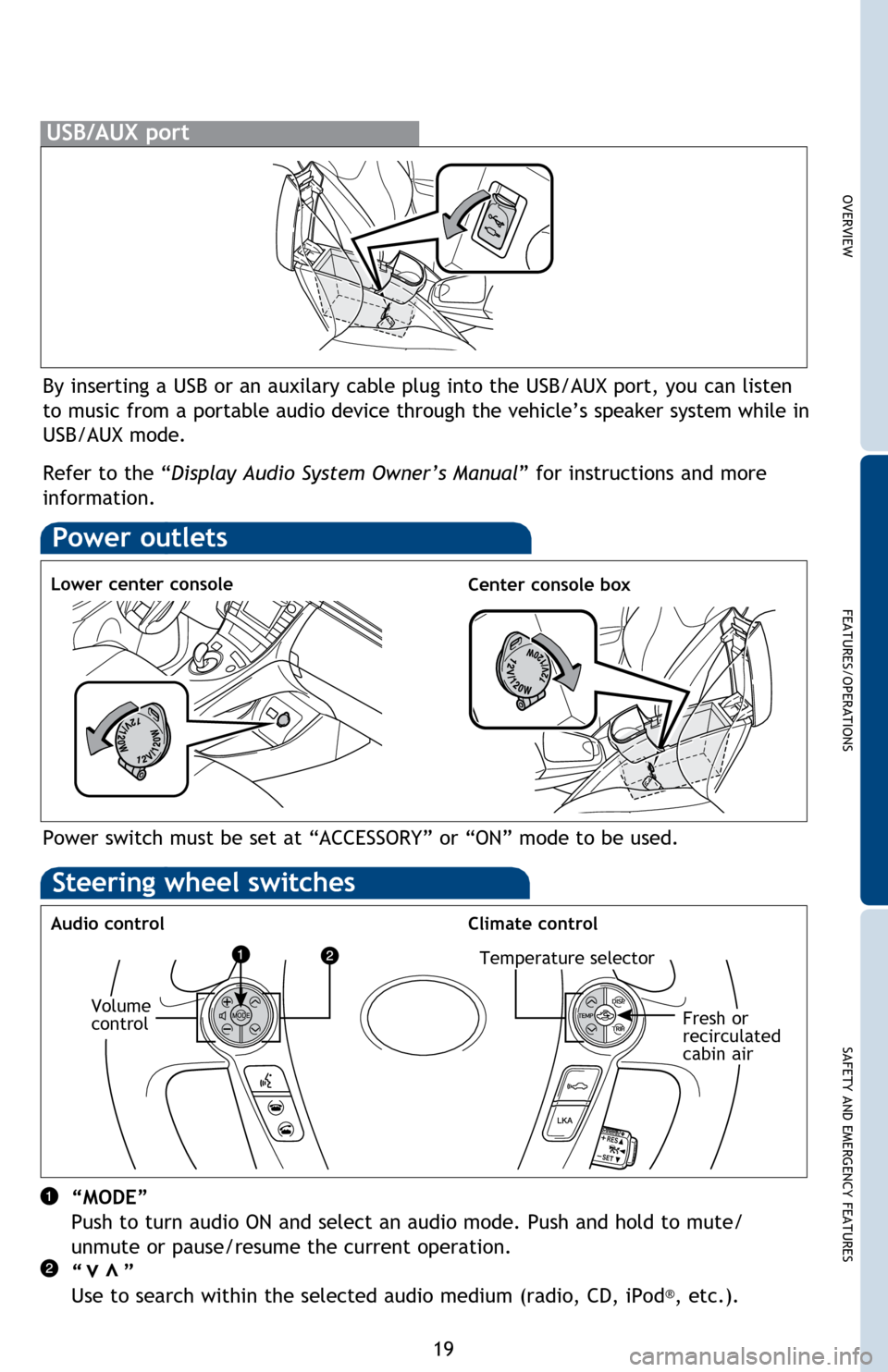
OVERVIEW
FEATURES/OPERATIONS
SAFETY AND EMERGENCY FEATURES
19
By inserting a USB or an auxilary cable plug into the USB/AUX port, you can listen
to music from a portable audio device through the vehicle’s speaker system while in
USB/AUX mode.
Refer to the “Display Audio System Owner’s Manual
” for instructions and more
information.
USB/AUX port
Power outlets
Lower center console Center console box
Power switch must be set at “ACCESSORY” or “ON” mode to be used.
Steering wheel switches
Audio controlClimate control
“MODE”
Push to turn audio ON and select an audio mode. Push and hold to mute/
unmute or pause/resume the current operation.
“ ”
Use to search within the selected audio medium (radio, CD, iPod
®, etc.).
vv
Volume
control
Temperature selector
Fresh or
recirculated
cabin air
Page 22 of 32
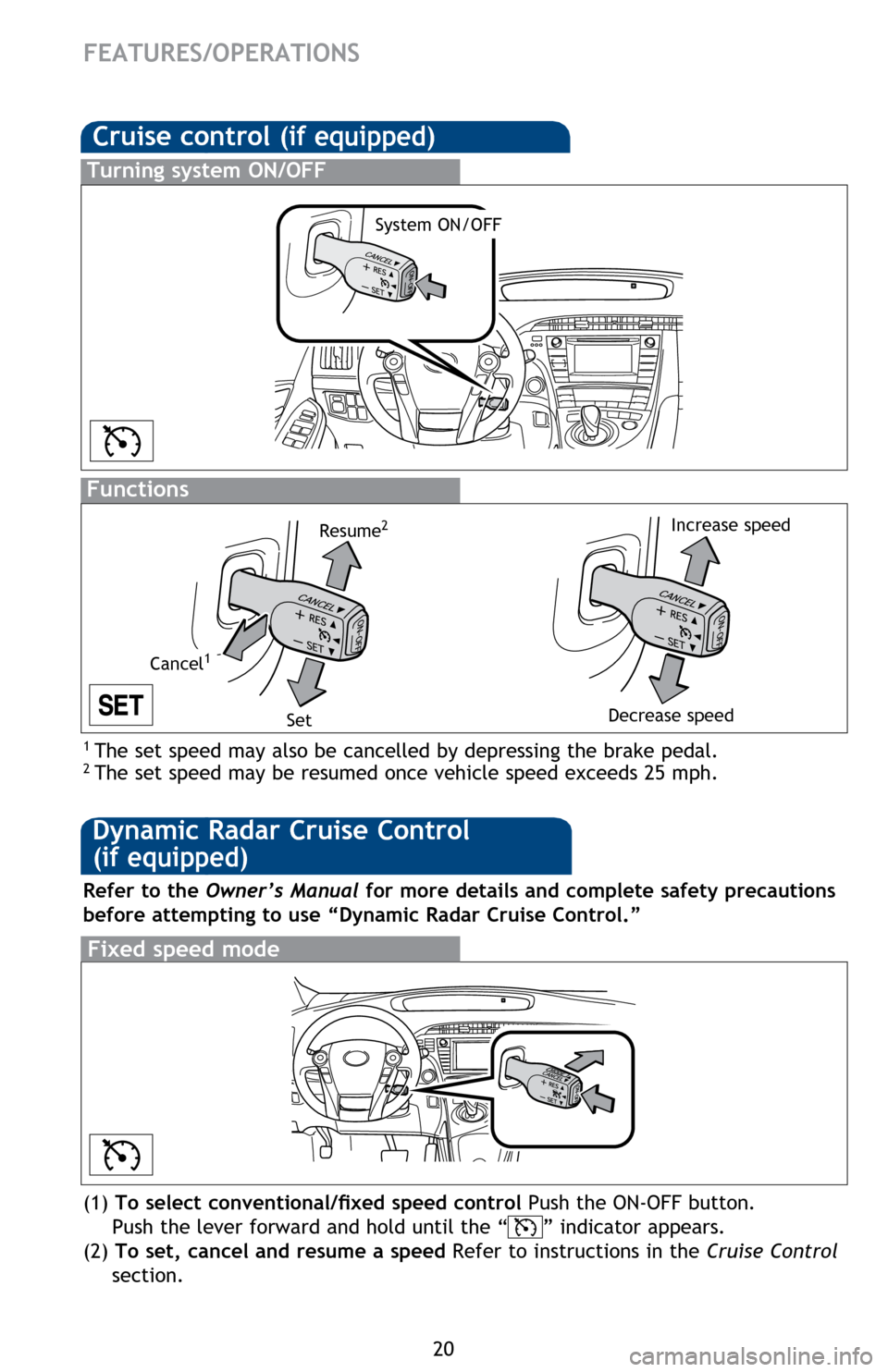
20
Cruise control (if equipped)
1 The set speed may also be cancelled by depressing the brake pedal.2 The set speed may be resumed once vehicle speed exceeds 25 mph.
Turning system ON/OFF
Functions
System ON/OFF
Increase speed
Decrease speed
Cancel1
Resume2
Set
(1) To select conventional/fixed speed control Push the ON-OFF button.
Push the lever forward and hold until the “
” indicator appears.
(2) To set, cancel and resume a speed Refer to instructions in the Cruise Control
section.
Fixed speed mode
Refer to the Owner’s Manual for more details and complete safety precautions
before attempting to use “Dynamic Radar Cruise Control.”
FEATURES/OPERATIONS
Dynamic Radar Cruise Control
(if equipped)
Page 23 of 32
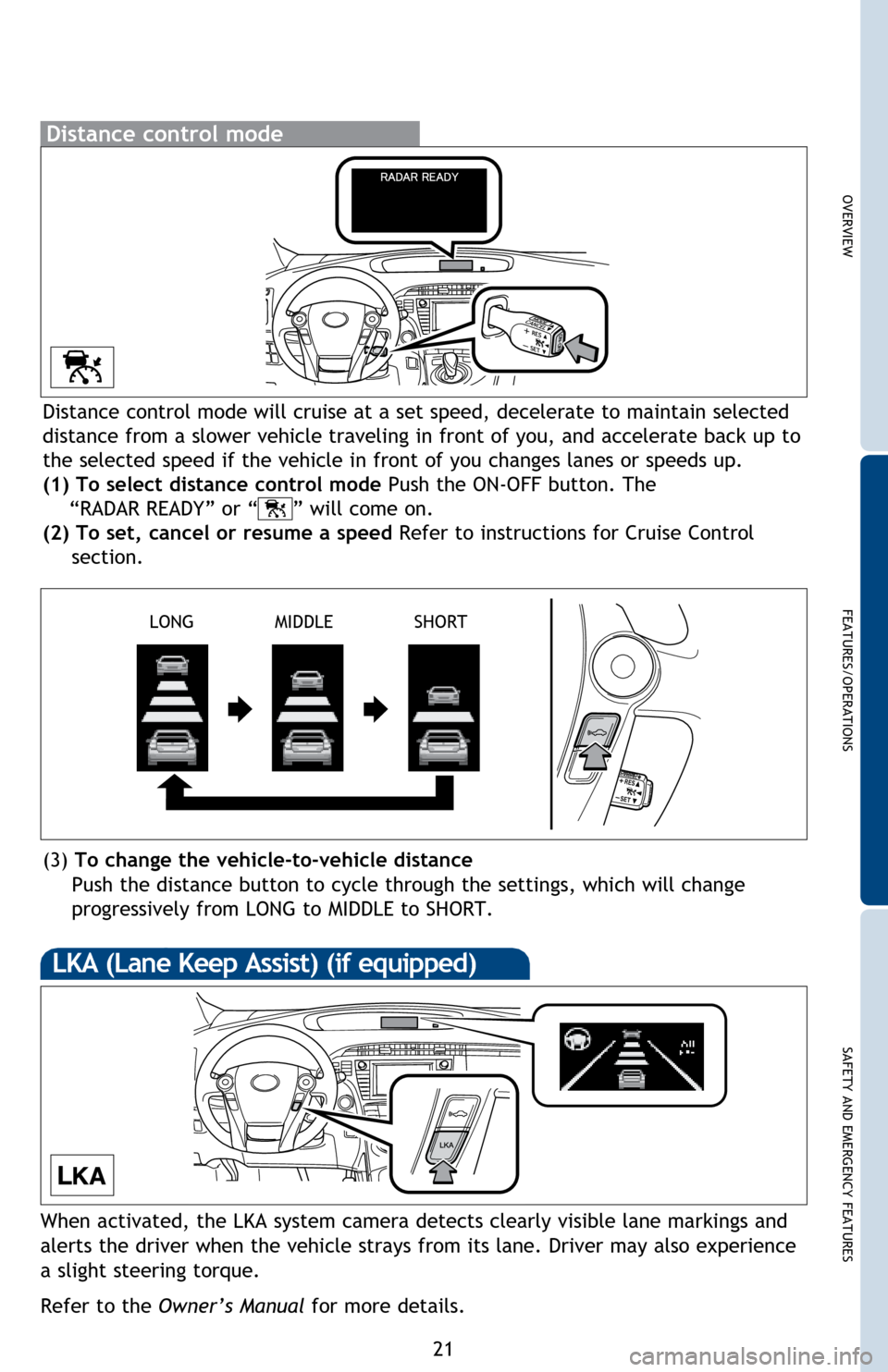
OVERVIEW
FEATURES/OPERATIONS
SAFETY AND EMERGENCY FEATURES
21
Distance control mode will cruise at a set speed, decelerate to maintain selected
distance from a slower vehicle traveling in front of you, and accelerate back up to
the selected speed if the vehicle in front of you changes lanes or speeds up.
(1) To select distance control mode Push the ON-OFF button. The
“RADAR READY” or “
” will come on.
(2) To set, cancel or resume a speed Refer to instructions for Cruise Control
section.
(3) To change the vehicle-to-vehicle distance
Push the distance button to cycle through the settings, which will change
progressively from LONG to MIDDLE to SHORT.
Distance control mode
LONG MIDDLE SHORT
LKA (Lane Keep Assist) (if equipped)
When activated, the LKA system camera detects clearly visible lane markings and
alerts the driver when the vehicle strays from its lane. Driver may also experience
a slight steering torque.
Refer to the Owner’s Manual for more details.
Page 24 of 32
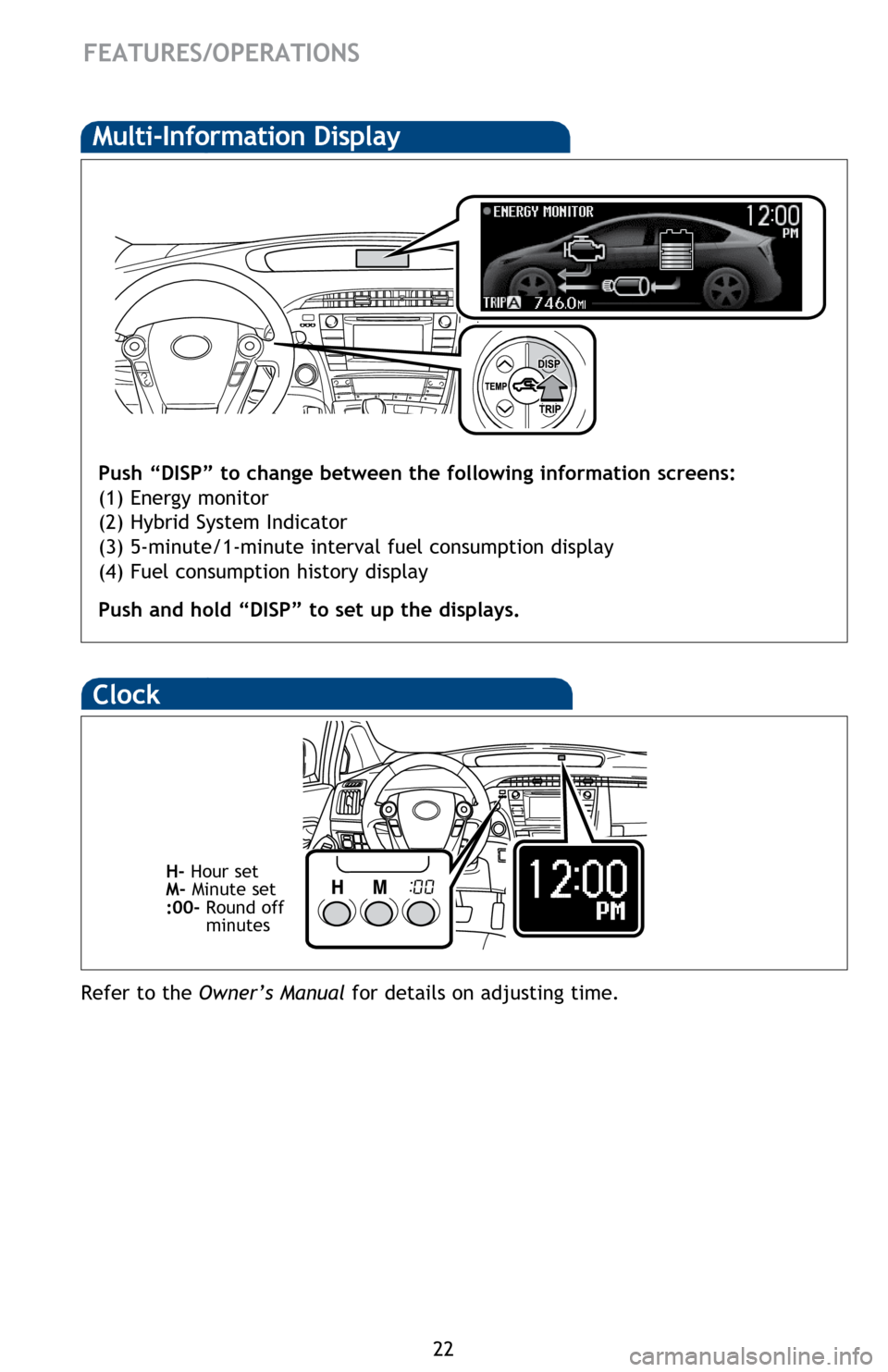
22
FEATURES/OPERATIONS
Multi-Information Display
Push “DISP” to change between the following information screens:
(1) Energy monitor
(2) Hybrid System Indicator
(3) 5-minute/1-minute interval fuel consumption display
(4) Fuel consumption history display
Push and hold “DISP” to set up the displays.
Clock
Refer to the Owner’s Manual for details on adjusting time.
H- Hour set
M- Minute set
:00- Round off
minutes
Page 25 of 32
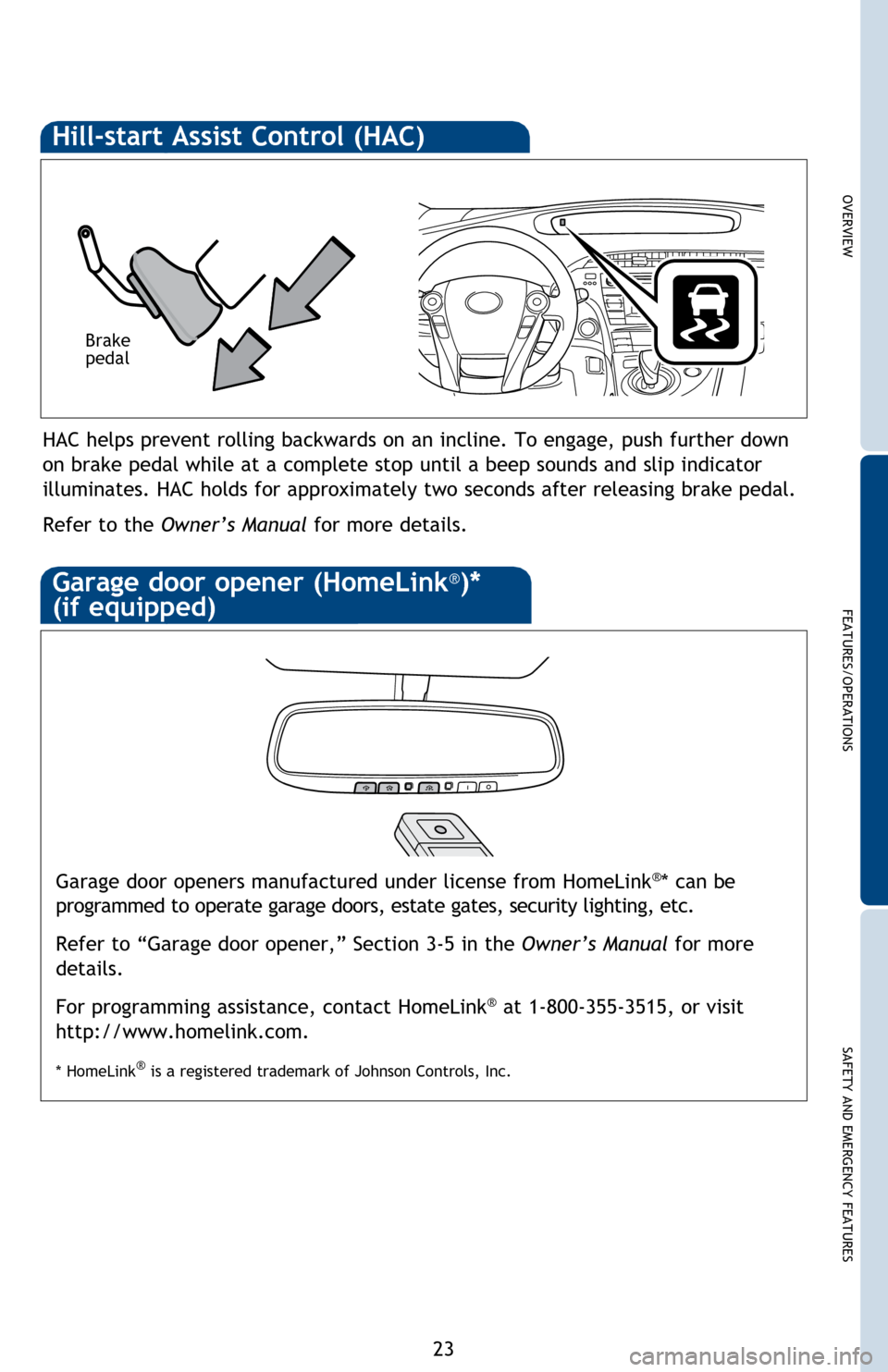
OVERVIEW
FEATURES/OPERATIONS
SAFETY AND EMERGENCY FEATURES
23
HAC helps prevent rolling backwards on an incline. To engage, push further down
on brake pedal while at a complete stop until a beep sounds and slip indicator
illuminates. HAC holds for approximately two seconds after releasing brake pedal.
Refer to the Owner’s Manual for more details.
Brake
pedal
Hill-start Assist Control (HAC)
Garage door openers manufactured under license from HomeLink®* can be
programmed to operate garage doors, estate gates, security lighting, etc\
.
Refer to “Garage door opener,” Section 3-5 in the Owner’s Manual for more
details.
For programming assistance, contact HomeLink
® at 1-800-355-3515, or visit
http://www.homelink.com.
* HomeLink® is a registered trademark of Johnson Controls, Inc.
Garage door opener (HomeLink®)*
(if equipped)
Page 26 of 32
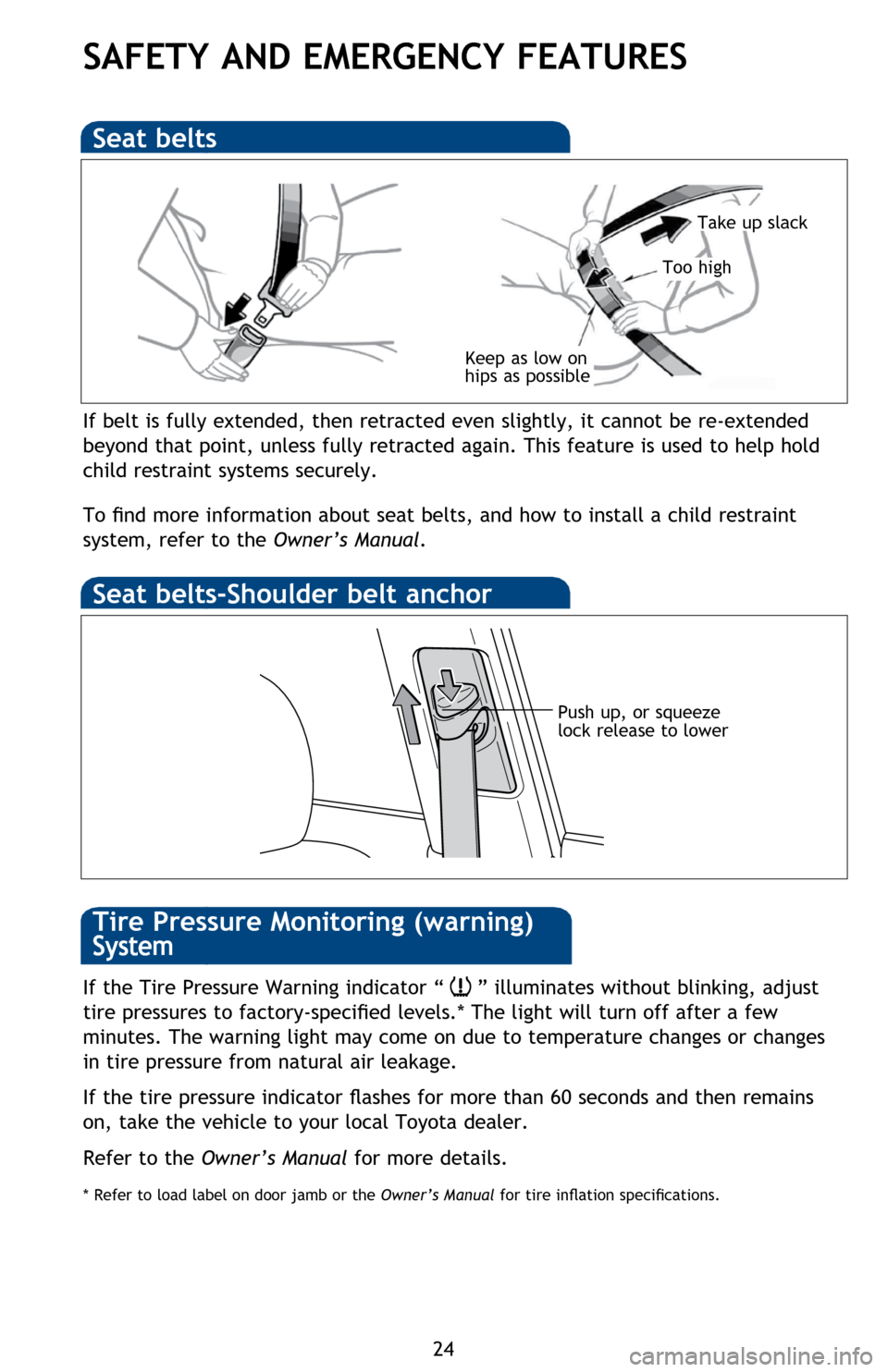
24
SAFETY AND EMERGENCY FEATURES
If belt is fully extended, then retracted even slightly, it cannot be re-extended
beyond that point, unless fully retracted again. This feature is used to help hold
child restraint systems securely.
To find more information about seat belts, and how to install a child restraint
system, refer to the Owner’s Manual.
Keep as low on
hips as possible
Take up slack
Too high
Seat belts
Push up, or squeeze
lock release to lower
Seat belts-Shoulder belt anchor
If the Tire Pressure Warning indicator “” illuminates without blinking, adjust
tire pressures to factory-specified levels.* The light will turn off after a few
minutes. The warning light may come on due to temperature changes or changes
in tire pressure from natural air leakage.
If the tire pressure indicator flashes for more than 60 seconds and then remains
on, take the vehicle to your local Toyota dealer.
Refer to the Owner’s Manual for more details.
* Refer to load label on door jamb or the Owner’s Manual for tire inflation specifications.
Tire Pressure Monitoring (warning)
System
Page 27 of 32
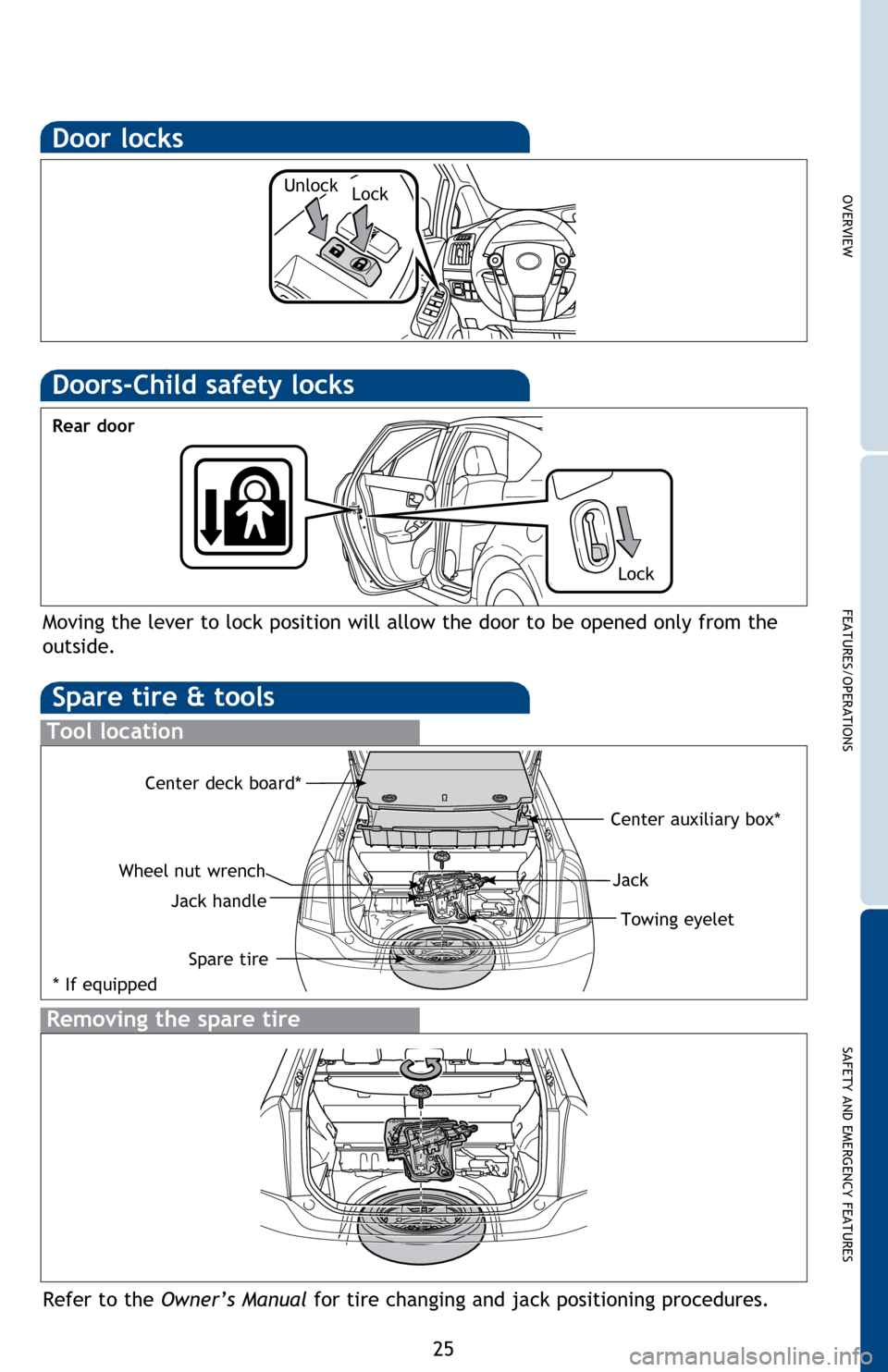
OVERVIEW
FEATURES/OPERATIONS
SAFETY AND EMERGENCY FEATURES
25
Door locks
Spare tire & tools
Tool location
Removing the spare tire
Refer to the Owner’s Manual for tire changing and jack positioning procedures.
Wheel nut wrench
Spare tire
Towing eyelet
Center auxiliary box*
Moving the lever to lock position will allow the door to be opened only from the
outside.
Rear door
JackJack handle
Doors-Child safety locks
Unlock
Center deck board*
* If equipped Lock
Lock
Page 28 of 32
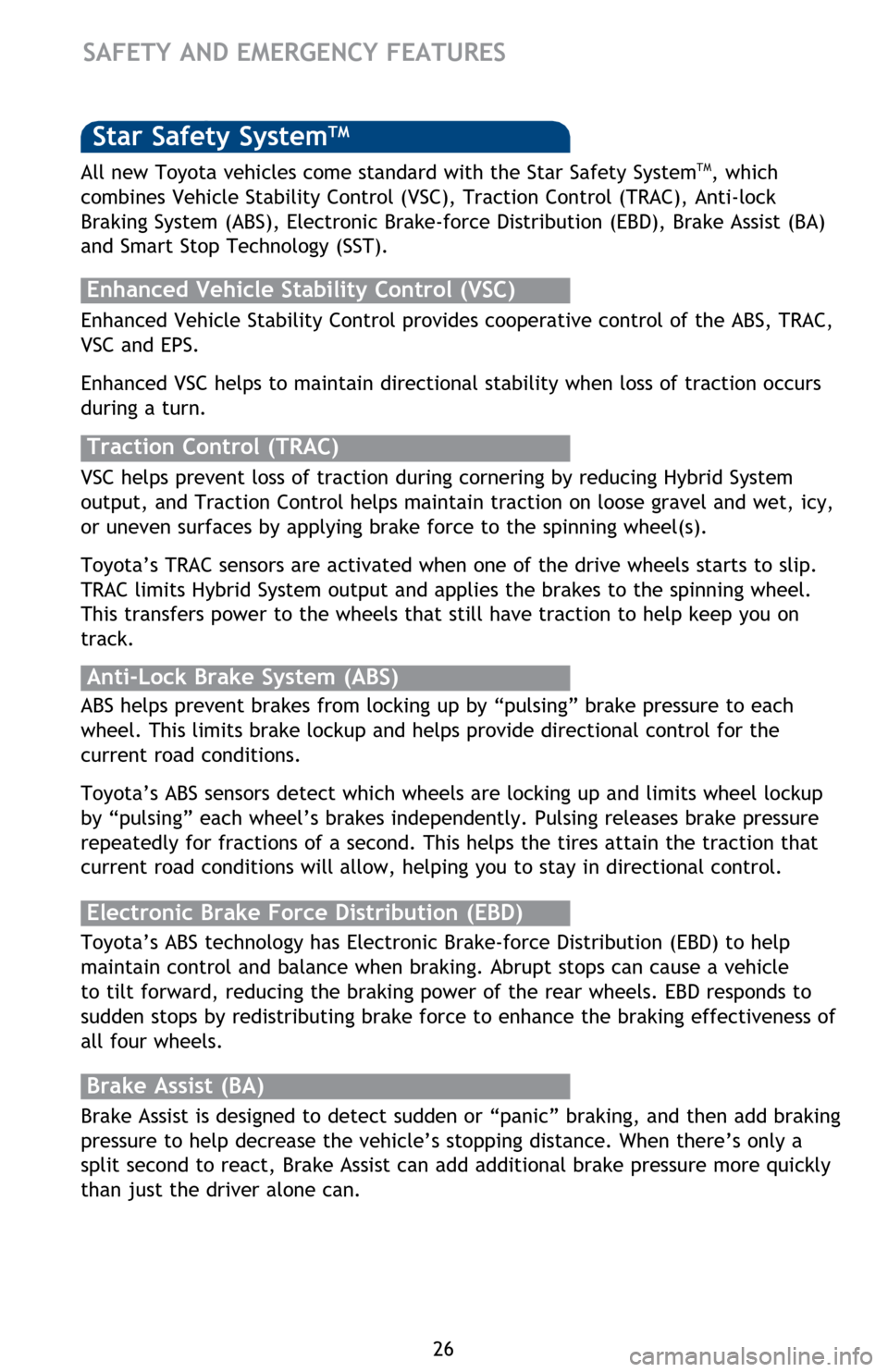
26
Star Safety SystemTM
Enhanced Vehicle Stability Control provides cooperative control of the ABS, TRAC,
VSC and EPS.
Enhanced VSC helps to maintain directional stability when loss of traction occurs
during a turn.
Enhanced Vehicle Stability Control (VSC)
Anti-Lock Brake System (ABS)
ABS helps prevent brakes from locking up by “pulsing” brake pressure to each
wheel. This limits brake lockup and helps provide directional control for the
current road conditions.
Toyota’s ABS sensors detect which wheels are locking up and limits wheel lockup
by “pulsing” each wheel’s brakes independently. Pulsing releases brake pressure
repeatedly for fractions of a second. This helps the tires attain the traction that
current road conditions will allow, helping you to stay in directional control.
Brake Assist (BA)
Brake Assist is designed to detect sudden or “panic” braking, and then add braking
pressure to help decrease the vehicle’s stopping distance. When there’s only a
split second to react, Brake Assist can add additional brake pressure more quickly
than just the driver alone can. VSC helps prevent loss of traction during cornering by reducing Hybrid System
output, and Traction Control helps maintain traction on loose gravel and wet, icy,
or uneven surfaces by applying brake force to the spinning wheel(s).
Toyota’s TRAC sensors are activated when one of the drive wheels starts to slip.
TRAC limits Hybrid System output and applies the brakes to the spinning wheel.
This transfers power to the wheels that still have traction to help keep you on
track.
Traction Control (TRAC)
Electronic Brake Force Distribution (EBD)
Toyota’s ABS technology has Electronic Brake-force Distribution (EBD) to help
maintain control and balance when braking. Abrupt stops can cause a vehicle
to tilt forward, reducing the braking power of the rear wheels. EBD responds to
sudden stops by redistributing brake force to enhance the braking effectiveness of
all four wheels.
SAFETY AND EMERGENCY FEATURES
All new Toyota vehicles come standard with the Star Safety SystemTM, which
combines Vehicle Stability Control (VSC), Traction Control (TRAC), Anti-lock
Braking System (ABS), Electronic Brake-force Distribution (EBD), Brake Assist (BA)
and Smart Stop Technology (SST).
Page 29 of 32
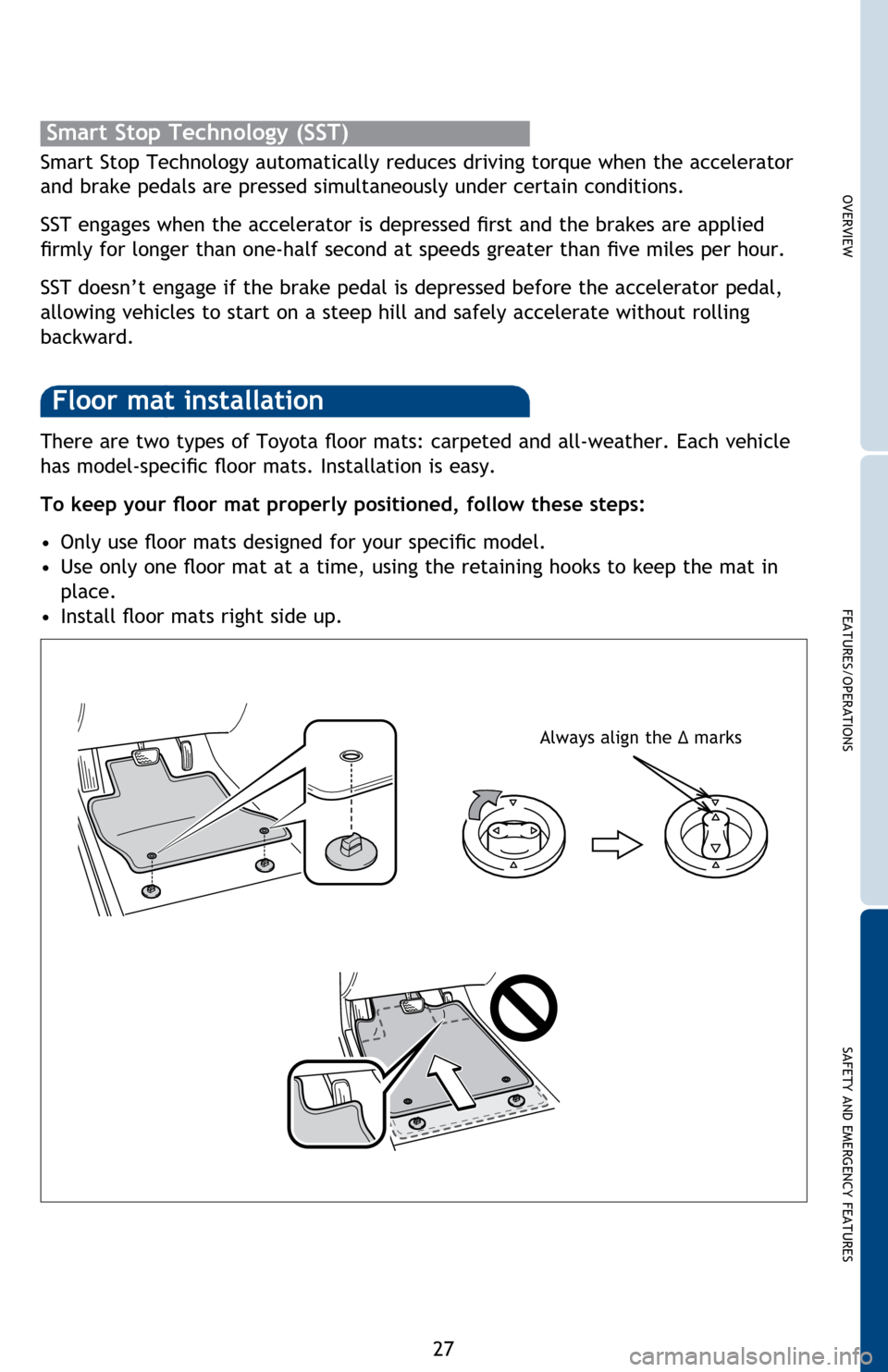
OVERVIEW
FEATURES/OPERATIONS
SAFETY AND EMERGENCY FEATURES
27
There are two types of Toyota floor mats: carpeted and all-weather. Each vehicle
has model-specific floor mats. Installation is easy.
To keep your floor mat properly positioned, follow these steps:
•
Only use floor mats designed for your specific model.
• Use only one floor mat at a time, using the retaining hooks to keep the mat in
place.
• Install floor mats right side up.
Floor mat installation
Smart Stop Technology automatically reduces driving torque when the accelerator
and brake pedals are pressed simultaneously under certain conditions.
SST engages when the accelerator is depressed first and the brakes are applied
firmly for longer than one-half second at speeds greater than five miles per hour.
SST doesn’t engage if the brake pedal is depressed before the accelerator pedal,
allowing vehicles to start on a steep hill and safely accelerate without rolling
backward.
Smart Stop Technology (SST)
Always align the Δ marks
Page 30 of 32

28
NOTES